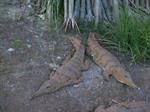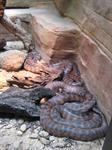
REPTILE BEHAVIOUR
Reptiles have a relatively small brain compared with a mammal, for example:
The most common defence for reptiles is to avoid enemies. If they feel threatened, snakes and lizards tend to move away. Crocodiles and turtles will tend to sink down in water if threatened.
If cornered, crocodiles, turtles and even some lizards will tend to hiss, or make a noise by vibrating their tails (eg. a rattlesnake; or other snakes can create noise moving the tail in dry foliage on the ground)
Some reptiles can use body posturing if threatened (eg. a cobra or frilled necked lizard enlarging its neck to make itself appear bigger). Some lizards can flatten their bodies to make themselves appear larger when threatened. Many other lizards and snakes will face an enemy with the head held high and mouth open when faced by an enemy (though they may well not strike).

A display of bright colour is also often a defence mechanism.
Other defence behaviours can include
-
spitting venom
-
balling (coiling up and hiding the head under the body)
-
secreting foul smelling odours from musk glands
-
flicking a tail (some lizards have thick or horny tails that are a useful weapon);
Crocodilians
Crocodilians include the crocodiles, alligators, caimans and gavials (or gharials). They are found throughout the equatorial regions. They inhabit all continents except Europe and Antarctica in aquatic environments.
Crocodilians, although all semi-aquatic, exhibit a range of behaviours. The young generally prey on arthropods and frogs. As size increases, large vertebrate prey constitute most of their diet, however, they still feed on small prey. Most crocodilians take hold of large prey by using forward lunges or rapid sideways head movements. At times they propel themselves out of the water to grasp prey. Most species can lunge the length of their body and some species such as the salt water crocodile can lunge vertically. They use gravity to move food into the gullet.
Crocodilians use complex vocalizations and visual cues in social behaviour. These can include gaping, bellowing, nasal blowing, tail wagging, head slapping, snout lifting and body inflation. These cues are given to show a range of dispositions such as asserting dominance, submissive behaviour and conciliation. Most cues are given in the water which provides an acoustic and visual advantage.
Female crocodilians invest large amounts of energy in parental care. They create a nest from soil and vegetation. They guard these during the incubation period. Mothers then move babies from the nest to the water when they hatch. They then guard them in the water for weeks and sometimes months.
Some crocodilians are only territorial during the breeding season. The Nile Crocodiles (Crocodylus niloticus) are one of the more social species that hunt and feed cooperatively. Others, such as the Saltwater Crocodile (Crocodylus porosus) are more combative and regularly fight within their species.
DO YOU WANT TO LEARN MORE ABOUT REPTILES?
Why not have a look at our Herpetology course?
